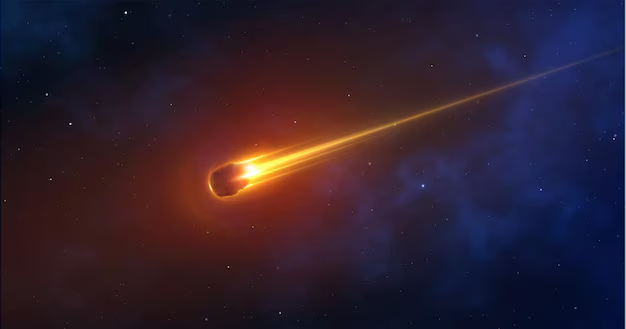Interstellar comet 3I/ATLAS, unveiled in July 2025, is captivating the global scientific community as a direct visitor from the depths of space, originating far outside our solar system. This rare cosmic object offers a once-in-a-generation view into materials and processes that predate our sun and planets by billions of years, providing clues to the mysteries of planetary formation and—possibly—the origins of life itself.
Table of Contents
Discovery of 3I/ATLAS
3I/ATLAS, also known as C/2025 N1 (ATLAS), was first detected on July 1, 2025, by the NASA-funded Asteroid Terrestrial-impact Last Alert System (ATLAS) telescope in Río Hurtado, Chile. The object’s hyperbolic path, abnormally high velocity, and trajectory pointing from the constellation Sagittarius quickly marked it as interstellar, unlike the much more common solar system comets.
It is only the third confirmed interstellar object to traverse our solar system, after 1I/ʻOumuamua (2017) and 2I/Borisov (2019).
Its official designation “3I” indicates it as the third interstellar object; “ATLAS” acknowledges the discovery system.
Trajectory and Interstellar Origin
3I/ATLAS travels on a sharply hyperbolic path, moving so fast that it’s escaping the gravitational clutch of the Sun forever.
The comet’s orbital eccentricity is a striking 6.141—far exceeding the typical value for even hyperbolic comets and indicating a clear, straight-line path through the solar system.
Its hyperbolic excess velocity is 58 km/s (about 130,000 mph), much faster than the two earlier interstellar visitors.
The minimum Earth-approach distance will be around 1.8 AU (about 270 million km), ensuring it poses no threat to Earth.
Origin modeling suggests it most likely comes from the Milky Way’s “thick disk”—a galactic region populated by ancient stars and primordial material. Simulations further point to an age that could exceed 7 billion years, making it possibly the oldest comet ever observed in the solar system.
Physical Characteristics and Observations
Nucleus and Coma
Like most comets, 3I/ATLAS consists of a nucleus—a solid, icy core—surrounded by a diffuse coma. Yet several factors make it truly unique:
Size estimates of its nucleus range from under 1 km to up to 30 km, with recent data converging on the smaller end but not definitively settled due to its active coma.
The Hubble Space Telescope delivered the sharpest images, enabling precise size and brightness measurements.
Composition
Spectroscopy from the Hubble Space Telescope and James Webb Space Telescope (JWST) has revealed the following:
An unusually high abundance of carbon dioxide, alongside water ice, carbon monoxide, water vapor, and traces of carbonyl sulfide.
Cyanide gas and atomic nickel have also been detected, with ice and organic compounds hinting at pre-solar, primordial chemistry.
These features suggest that 3I/ATLAS brings ancient material—possibly unaltered since the galaxy’s infancy—into scientific reach.
Activity and Tail
As 3I/ATLAS neared the Sun, it developed a bright coma and prominent tail—gas and dust ejected by solar heating.
Its cometary activity has been stable, and astronomers have not detected sudden “outbursts” or fragmentation, such as those seen in 2I/Borisov.
The brief observational window before it slips behind the sun adds urgency to ongoing studies by ground and space telescopes, as well as several ESA and NASA probes in the inner solar system.
Scientific Significance
3I/ATLAS is more than just an astronomical curiosity—it is a precious messenger from the wider galaxy.
The comet’s materials may predate the sun and planets, potentially holding clues to the raw ingredients that form planetary systems.
The diversity of volatile compounds inside provides a “cosmic time capsule” of ancient chemistry, highlighting similarities and differences with comets born around our Sun.
Such independent origins support theories about panspermia—the possibility that life’s building blocks can travel between star systems on interstellar objects like comets.
The trajectory, age, and origin (thick disk) make it a unique probe of galactic history, previously unavailable to science.
What’s Next for 3I/ATLAS?
3I/ATLAS will remain visible to telescopes until September 2025; beyond then, it will slip too close to the sun for observations from Earth.
A constellation of Mars and Jupiter spacecraft is leveraging their vantage point near the sun to continue observations after the comet vanishes from our night sky.
Scientists intend to analyze the comet’s trajectory, composition, and evolution exhaustively, squeezing every last bit of data before it fades from view forever.
FAQs
What is comet 3I/ATLAS?
3I/ATLAS is the third recorded interstellar object to pass through our solar system, discovered in July 2025 by the ATLAS telescope in Chile. Unlike comets from our solar system, its origin is outside our own system, earning it the “interstellar” label.
Why is this comet important?
It delivers incredibly rare insight into the chemistry and formation environments of other star systems, far older than our own, and even offers clues about the building blocks of life in the galaxy.
What makes its path interstellar?
Its sharply hyperbolic orbit and excess velocity mean it’s not gravitationally bound to the Sun; it is simply passing through our system, never to return, and will exit just as quickly as it arrived.
How old is interstellar comet 3I/ATLAS?
Models suggest it could be over 7 billion years old, originating from the thick disk of the Milky Way—making it potentially the oldest comet ever studied.
What is it made of?
The comet hosts carbon dioxide, water ice, carbon monoxide, cyanide, complex organics, and atomic nickel—providing a sample of the primordial building blocks that went into forming stars and planets.
Can it be seen from Earth?
Yes, during a brief visibility window until September 2025 it could be observed by powerful ground-based and space telescopes. After it hides behind the sun, only probes in space can track it.
Will 3I/ATLAS return?
No. Its speed and path ensure it will leave the solar system forever.
Is there any risk to Earth?
No, it will not come closer than about 1.8 AU—almost twice the distance between the Earth and the Sun.
What does interstellar comet 3I/ATLAS stand for?
“3” = third interstellar object, “I” = interstellar, “ATLAS” = the telescope system that discovered the comet.
Conclusion
The passage of interstellar comet 3I/ATLAS through our solar system is not just an astronomical event—it is a revelation, offering a direct sample of galactic history and affirming the interconnectedness of cosmic phenomena. Each observation helps refine humanity’s place in the universe, adding another verse to the epic story of our origins, destiny, and the grand sweep of cosmic evolution.












